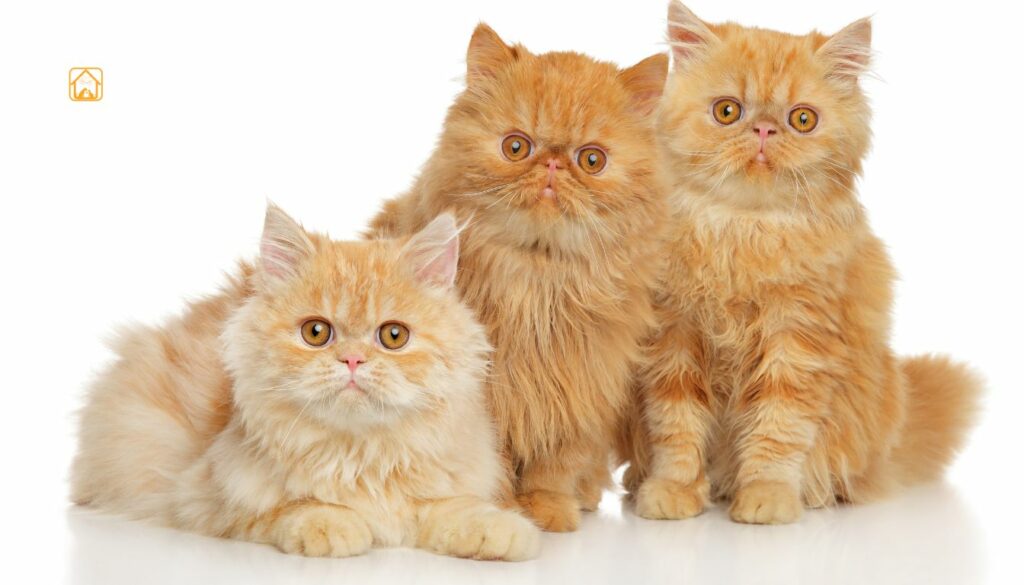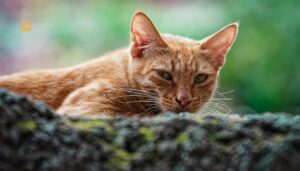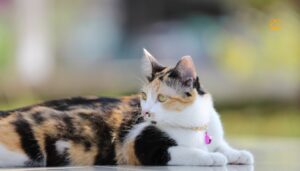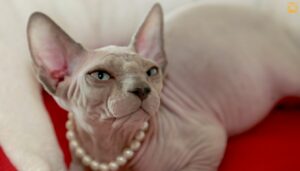History and Origins of Persian Cats
Persian cats have a story that stretches back centuries. Their ancestors likely roamed Mesopotamia, now modern-day Iran, before charming their way into European homes in the 1600s. Some say Italian nobleman Pietro Della Valle brought the first longhaired beauties to the West. Over time, these cats became the pampered pets of royalty and the stars of cat shows everywhere.
Persians didn’t always have the signature flat faces we see in some types today. That trait appeared in the 1950s, the result of a spontaneous gene mutation. Breeders fell in love with the look, and so began the era of different types of Persian cats based on facial structure. Today’s Persian cats are a blend of tradition and selective breeding, adored for their personalities and elegant coats.
Physical Traits of Persian Cats
When you meet a Persian cat, certain features stand out right away. Their big, round eyes (often copper, green, or blue), broad heads, and thick, luxurious coats are hard to miss. But there’s a lot more to their looks than just “fluffy and cute.”
- Face Types: The most famous distinction is between doll face (classic profile) and peke-face (flat or ultra-flat profile). More on this in the next section.
- Coat: Persians have some of the densest, longest fur around, complete with a plush undercoat and silky topcoat. This means lots of grooming, but also lots of beauty.
- Body: Stocky and low to the ground, Persians have strong bodies, short legs, and rounded paws. They’re not big jumpers, often preferring the comfort of the floor or a plush couch.
- Tail: Short, thick, and bushy, it’s like a feather duster trailing behind them.
- Eye Colors: Depends on coat color. Some Persians have striking copper eyes, while others, especially white or chinchilla types, may have blue, green, or even odd-colored eyes.
Color Variations and Coat Types
If you think all Persian cats look the same, think again. There are over 100 recognized coat colors and patterns! Some of the most popular include:
- Solid Persian cats: One consistent color (white, black, blue, cream, etc.).
- Bicolor and Calico: Combinations like white with black or orange patches.
- Chinchilla Persian: Silvery-white fur with dark tips.
- Colorpoint (Himalayan): Cream body with darker “points” on ears, face, paws, and tail.
The variety is almost dizzying! I once met a Himalayan Persian whose blue eyes seemed to glow in the sunlight. Each coat type brings its own charm, and grooming needs.
The Main Types of Persian Cats: Overview
So, how many types of Persian cats are there? While there’s only one Persian breed, there are several recognized Persian cat breed variants based on facial structure, size, and coat:
- Doll Face Persian
- Peke-Face Persian
- Chinchilla Persian
- Exotic Shorthair
- Teacup Persian
- Himalayan (Colorpoint)
Each type brings something unique to the table, from playful personalities to dramatic looks.
Doll Face Persian Cats
Doll Face Persians are often considered the more natural version of the Persian cat, with a sweet, expressive face that’s not as flat as show-style Persians. Their nose is slightly longer, giving them fewer breathing and eye issues. These cats are gentle, calm, and affectionate, making them ideal for relaxed homes. They have the signature long, silky coat and come in many colors. Doll Faces are loved for their beauty, grace, and slightly more active personality compared to their flat-faced cousins.
Peke-Face Persian Cats
The Peke-Face Persian is known for its extremely flat face, resembling a Pekingese dog hence the name. This type has a pushed-in nose, round eyes, and a very short muzzle, giving it that dramatic, doll-like appearance. While striking, the flat face can bring breathing, eye, and tear-staining issues. They’re quiet, affectionate lap cats who enjoy a peaceful home. Regular grooming is a must, and they thrive best with attentive care. Peke-Face Persians are often the stars of Persian cat shows due to their distinct features.
Chinchilla Persian Cats
Chinchilla Persians are a stunning variety known for their sparkling silver or golden coats and soft, shaded fur. Their green or blue-green eyes are outlined in black, giving them a naturally made-up look. Unlike extreme Persians, Chinchillas have a more moderate facial structure, which helps reduce breathing problems. They’re calm, affectionate, and love quiet companionship. Because of their luxurious coat, they need regular grooming. Chinchilla Persians are often seen as elegant and royal, thanks to their fairy-tale appearance and gentle nature.
Exotic Shorthair Persian Cats
Exotic Shorthairs are often called the “lazy man’s Persian” because they share the same body type and face as Persians but with a short, plush coat that’s much easier to manage. These cats are affectionate, playful, and a little more active than their long-haired cousins. Their big round eyes and teddy bear look make them irresistible. Exotic Shorthairs enjoy cuddles but also love to explore and play. They’re a great choice for someone who wants the Persian look without the high-maintenance grooming.
Teacup Persian Cats
Teacup Persians are miniature versions of the traditional Persian cat, typically weighing between 4 to 7 pounds. They have the same fluffy coat, sweet personality, and calm temperament but in a much smaller package. Their petite size makes them especially popular, but it also means they can be more delicate and may require extra care. These cats are ideal for apartment living and quiet homes. Regular grooming is still essential, and gentle handling goes a long way with these tiny companions.
Himalayan Persian Cats
The Himalayan is a beautiful blend of Persian and Siamese traits, known for its long, silky coat and Siamese-style color points on the face, ears, paws, and tail. Their stunning blue eyes and soft voices add to their charm. Himalayans are gentle, affectionate, and enjoy lounging in quiet spaces. They do need daily grooming to keep their fur tangle-free. While playful at times, they prefer calm environments and loving routines. This breed is perfect for those who want elegance with a touch of playfulness.
Other Notable Persian Cat Types
- Shaded & Smoke Persians: These cats have coats that look different depending on the light, with distinctive color-tipped fur. They’re eye-catching and elegant.
- Solid Persians: Classic, all-one-color Persians, white, black, blue, cream, are the foundation of the breed. Their timeless look never goes out of style.
- Particolor & Bicolor Persians: These Persians sport a mix of two or more colors, making each cat unique. Bicolors can even have quirky markings like mustaches or “hats.”
Care and Grooming Needs by Persian Type
Grooming needs can vary by Persian type and coat. Let’s make sure your fancy feline stays as fabulous as they deserve.
- Traditional Longhaired Persians (Doll Face & Peke Face): Expect to brush daily, those long, double coats tangle if you blink. Mats are no joke; they can cause skin problems if ignored. Use a wide-toothed comb for the undercoat and a soft brush for finishing touches. Some owners swear by a monthly bath, while others do it every few weeks.
- Exotic Shorthair: Thanks to their short, plush coat, Exotics need less brushing, once or twice a week usually does it. But don’t slack on face cleaning, especially for peke-face Exotics.
- Chinchilla & Silver/Golden Persians: Their fine, light fur mats quickly, so gentle, regular grooming is a must. Regular baths help keep that sparkling look. Be extra gentle around the eyes, these types often have sensitive skin.
- Bicolor, Particolor, and Solid Persians: Grooming depends more on coat length than pattern, but white or light-colored cats may need more frequent cleaning to avoid staining (especially around eyes and mouth).
- Teacup Persians: Their coats are often just as thick as standard Persians, but their tiny bodies mean you have to be extra gentle. Short sessions, lots of treats, and patience go a long way.
Health, Care and Maintenance of Persian Cat Types
Health is a big topic when you’re talking about the different types of Persian cats, especially if you’re thinking about flat-faced (peke-face) versus doll face, or the miniaturized teacup types. Here’s what every Persian parent should know, no sugarcoating.
Brachycephalic Syndrome
Peke-face and show Persians often suffer from this condition, which means their flat faces can cause breathing issues, noisy snoring, and sometimes trouble eating or even playing. I’ve seen cats whose whole world changes after a simple surgery to open their nostrils, but prevention is always better, if you love the flat look, be ready for extra vet visits.
Eye Drainage
Those big, round eyes are gorgeous but can be a tear-jerker, literally. Flat-faced Persians often have blocked tear ducts, causing constant eye discharge. Daily cleaning is key to avoid stained fur and infections.
Dental Problems
The compressed jaw of peke-face Persians can lead to crowded, misaligned teeth and gum disease. Regular dental checks and tooth brushing make a huge difference.
Polycystic Kidney Disease (PKD)
This genetic condition is common in Persian cats of all types. Reputable breeders test for PKD, but always ask for proof, there’s no such thing as being “too careful.”
Hypertrophic Cardiomyopathy (HCM)
This heart condition can affect any Persian, regardless of face type or color. Yearly exams and early detection help manage the risk.
Teacup Persians
Their tiny size may look cute, but it can mean bone fragility, trouble regulating body temperature, and even neurological issues. Teacups often need more TLC and can rack up higher vet bills.
Himalayan Persians
While generally healthy, they can inherit respiratory issues from their Persian side and are prone to the same genetic diseases.
Choosing the Right Type of Persian Cat for Your Home
Picking the right Persian cat comes down to your lifestyle and preferences. Want a low-maintenance companion? An Exotic Shorthair might be your match. Prefer the traditional look with fewer health worries? Go for a doll face or chinchilla. Ready for the show-stopping drama of a peke-face? Just be prepared for extra care.
Think about your time for grooming, willingness to manage health needs, and what kind of personality you’re hoping for. Every Persian cat is unique, but finding the right fit makes for a lifelong friendship. And, hey, sometimes it’s the quirkiest cat that steals your heart.
FAQs About Types of Persian Cats
How many types of Persian cats are there?
There is one Persian cat breed, but several recognized types based on face shape, size, and coat color, like doll face, peke-face, chinchilla, Himalayan, Exotic Shorthair, and teacup Persian cats.
What are the main face types of Persian cats?
The two types of Persian cat faces are “doll face” (classic, rounded profile) and “peke-face” (flat, pushed-in face). Each has its own look and health considerations.
Which type of Persian cat is healthiest?
Doll face and chinchilla Persians tend to have fewer breathing and eye issues. Flat-faced types are more prone to health problems, so regular vet care is important.
Are teacup Persian cats good pets?
Teacup Persians are cute but can be fragile and prone to health issues. They’re best for experienced, gentle owners who can provide extra care and attention.
What’s the difference between an Exotic Shorthair and a regular Persian?
Exotic Shorthairs have the same body and face as Persians but with a short, plush coat that’s easier to groom. They’re often more playful and outgoing, too.
Do Persian cats come in different colors?
Yes! Persian cats come in many colors and patterns, including solid, bicolor, calico, chinchilla, and Himalayan (colorpoint) variations.
How do I choose the best type of Persian cat for my family?
Consider grooming time, health needs, and personality. Meet different types, ask breeders or shelters about temperament, and choose the Persian cat that fits your lifestyle best.
Conclusion
For more tips on Persian cat care or adopting your next feline friend, check resources like the Cornell Feline Health Center, or check out our guides on cat breeds here at Petshelter.org.



